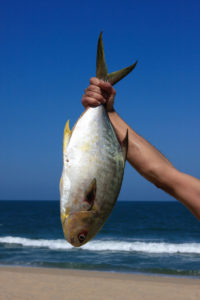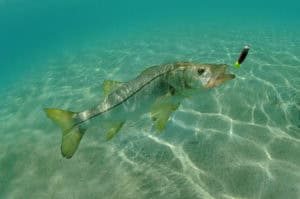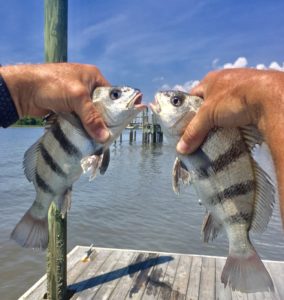Every angler knows the significance of well-equipped gear in the pursuit of the perfect catch. But what separates successful anglers from the rest is a deep understanding of the intricate dance between nature’s rhythms and fishing outcomes.
Moon phases significantly influence saltwater fishing by driving tides and impacting the feeding behavior of marine species, allowing anglers to optimize their strategies for better success.
This symbiotic relationship between environment and angling strategy can transform a fishing trip into a memory-laden adventure.
With a myriad of water bodies at our disposal and fishing gear catering to various budgets, knowing when to cast your line could be the difference between a legendary catch and a tale of the one that got away.

Moon Phases and Fishing Dynamics
Just as the moon exerts its gravitational pull on tides, it also leaves its mark on fish behavior. Similar to deer, fish display peak activity during the days preceding and following full and new moons.
This effect is most pronounced when the moon rise or moon sets coincides with sunrise or sunset. For saltwater fish, the moon wields an even mightier influence, sparking extreme high and low tides.
Elevated tides can entice fish into uncharted feeding grounds, especially if they align with the spawning cycles of prey fish, making them easier targets.
Conversely, reduced tides may funnel fish into spots that are typically untouched during standard water levels.

Discover the core principles of saltwater fishing in my article “Diving into Saltwater Fishing: Understanding the Fundamentals.” Your gateway to a rewarding and thrilling angling experience awaits
Weather’s Ballet on Fishing Success
Temperature Fluctuations: Each fish species has its own comfort zone when it comes to water temperature. Even minor deviations caused by consecutive hot or cold days can drastically impact fish activity, especially in smaller water bodies.
Sun vs. Clouds: The allure of a sunny day might be strong, but the real action happens on overcast days or when a gentle drizzle graces the waters.
Clouds obliterate sharp shadows along the banks, reducing the fish’s wariness. Predatory fish, equipped with superior low-light vision compared to their prey, become more efficient hunters in such conditions.
Dusk and dawn, characterized by their muted lighting, emerge as golden windows for successful fishing.
Heavy rain can temporarily put a damper on the bite, particularly in smaller water bodies. Wind is another variable to consider.
In certain scenarios, wind-generated water turbulence can propel baitfish toward the shore, presenting a lucrative hunting opportunity for game fish. However, excessive wind can render fishing challenging and unsafe.
Barometric Pressure’s Role: Among all the weather factors, barometric pressure stands as a reliable indicator of fish activity. As the barometer drops, fish intensify their feeding activity, peaking just before inclement weather sets in.
This moment demands fast and aggressive fishing tactics. After the storm passes and a high-pressure system ushers in clear, cool days, the bite diminishes promptly, necessitating a shift to a more subtle, patient approach.
As barometric pressure stabilizes, fishing conditions gradually normalize.

Unmasking Moon Phases and Inshore Fishing Dynamics
Can moon phases genuinely sway fishing patterns? The unequivocal answer is yes. But it’s not the moon phases themselves that directly impact fish behavior; it’s their influence on tidal flow that holds the key.
Fish react to the vigorous tidal currents dictated by the moon’s gravitational pull. New and full moons, marked by heightened tidal fluctuations, correspond to increased fish feeding activity.
Spring and fall witness fish exploiting moments of robust tidal surges for spawning and egg dispersal. The majority of spawning activity coincides with new and full moons.

While fish aren’t moon phase connoisseurs, they do respond keenly to tidal flow. Hence, referring to tide charts for peaks during incoming and outgoing tides becomes a strategic move.
Optimal alignment of incoming or outgoing tides with new or full moon phases during early morning or late evening hours spells active, feeding fish. These periods witness frenzied spawning, making fish more susceptible to striking lures.
Explore essential insights for saltwater fishing enthusiasts in our article “Fishing Tips: Key Advice for Saltwater Fishing Enthusiasts.” Uncover valuable techniques and strategies to enhance your fishing endeavors and make the most of your time by the sea.
The Interplay of Tidal Flow and Spawning Success
In fishing, spring and fall take center stage for spawning, beautifully synchronized with new and full moon phases.
For instance, the revered trout reserves its spring activities for spawning. With water temperatures hovering around 70 degrees, trout activity escalates.
Spawning fish, hungry for sustenance, capitalize on vigorous tidal activity during new and full moons, fostering heightened feeding.
Fall brings forth prolific spawning for snook and redfish. Similar to trout, these species harness the intensified gravitational pull to disperse eggs over larger areas and indulge in more frequent feeding during new and full moons. Post-spawning, they refuel by consuming surplus calories.

In fall, migrating flounder shift their focus from estuaries, exhibiting feeding patterns intertwined with tidal flow. Amplified gravitational pull creates ‘conveyor belts’ of nourishment, accentuating feeding activity.
The greater the tidal-induced bait movement, the more the fish feed. Planning fishing expeditions around new and full moon phases boasting heightened tidal surges is a strategic move.
Enhancing Your Fishing Arsenal with Apps and Products
Apps for Anglers: Enhancing Your Fishing Experience
- Fishing Points: This app offers tide charts, weather forecasts, and fishing spots to optimize your angling trips.
- Fishbrain: Connect with a community of anglers, access fishing forecasts, and log your catches for comprehensive data.
Recommended Fishing Products for Your Next Adventure
- High-Quality Fishing T-Shirts: Show off your passion while staying comfortable during your fishing escapades.
- Stylish Fishing Hats: Shield yourself from the sun while adding a touch of flair to your fishing attire.

A Harmonious Dance with Nature for Angling Mastery
Fishing transcends being a mere hobby; it’s a blend of finesse, knowledge, and synchronizing with nature’s cadence. Moon phases, tidal dynamics, and weather patterns unite to deliver a harmonious fishing experience.
So, whether you’re a seasoned angler or a novice with dreams of trophy catches, attuning yourself to nature’s cues can elevate your fishing endeavors to unforgettable heights.

Disclaimer: The insights shared in this blog are based on general observations and angling experiences. Fishing outcomes can vary due to regional factors, species behavior, and local conditions. Always abide by fishing regulations, prioritize ecological well-being, and continue learning for angling excellence.
Stay tuned for more exhilarating angling insights, and until then, tight lines and bountiful catches!

